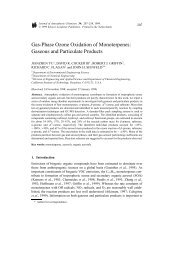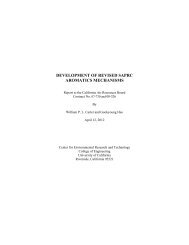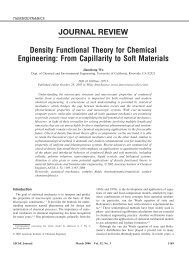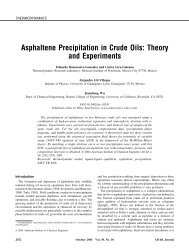Development of electroplated magnetic materials for MEMS
Development of electroplated magnetic materials for MEMS
Development of electroplated magnetic materials for MEMS
Create successful ePaper yourself
Turn your PDF publications into a flip-book with our unique Google optimized e-Paper software.
ARTICLE IN PRESS<br />
194<br />
N.V. Myung et al. / Journal <strong>of</strong> Magnetism and Magnetic Materials 265 (2003) 189–198<br />
Fig. 5. Residual stress <strong>of</strong> electrodeposited Ni, 85Co15Ni, and<br />
65Co15Ni20Fe films. Ni and 85Co15Ni were electrodeposited<br />
from sulfamate baths; 65Co15Ni20Fe film data is from<br />
literature [19].<br />
Fig. 4. Effect <strong>of</strong> current density on: (a) intrinsic stress <strong>of</strong> nickel,<br />
40Co60Ni, and 85Co15Ni films, and (b) microstructure <strong>of</strong> Ni<br />
films electrodeposited at different current densities. Nickel<br />
plating solution is 1 M Ni sulfamate bath, pH = 4.0, Temp =<br />
60 C; 40Co60Ni plating solution is 0.2 M NiCl 2 +0.05 M<br />
CoCl 2 +0.7 M NaCl+0.4 M boric acid+0.009 M NaH 2 PO 2<br />
+75 mM saccharin, 85Co15Ni plating solution is 0.2 M<br />
NiCl 2 +0.206 M CoCl 2 +0.7 M NaCl+0.4 M boric acid<br />
+0.009 M NaH 2 PO 2 +75 mM saccharin.<br />
saccharin to plating solutions can alter the residual<br />
stress <strong>of</strong> nickel from tensile to compressive.<br />
2.2. Hard <strong>magnetic</strong> <strong>materials</strong> in <strong>MEMS</strong><br />
Although s<strong>of</strong>t <strong>magnetic</strong> <strong>materials</strong> can be used<br />
to produce high-<strong>for</strong>ce actuators and sensitive<br />
magnetometers, hard <strong>magnetic</strong> or permanent<br />
<strong>magnetic</strong> <strong>materials</strong> would be more appropriate in<br />
some cases. For example, hard <strong>magnetic</strong> <strong>materials</strong><br />
with a high remanence, B r ; are well suited <strong>for</strong> bidirectional<br />
(push-pull) microactuator applications<br />
[20]. In addition, microactuators driven by <strong>of</strong>fchip<br />
coils can be activated with lower fields and<br />
hence lower power levels if a hard <strong>magnetic</strong><br />
material is used instead <strong>of</strong> a s<strong>of</strong>t <strong>magnetic</strong><br />
material. However, except in a few cases, hard<br />
<strong>magnetic</strong> <strong>materials</strong> have not been used extensively<br />
in <strong>MEMS</strong> [6]. The primary reason <strong>for</strong> this is the<br />
lack <strong>of</strong> readily available and reliable deposition<br />
and micromachining processes. A large variety <strong>of</strong><br />
hard <strong>magnetic</strong> <strong>materials</strong> can be prepared by<br />
metallurgical processes (e.g. sintering, pressure<br />
bonding, injection molding, casting, extruding,<br />
and calendaring), vacuum processes (e.g. evaporation,<br />
sputtering, MBE, CVD) and electrochemical<br />
processes (e.g. electroless deposition and electrodeposition).<br />
2.2.1. Magnetic properties <strong>of</strong> hard <strong>magnetic</strong><br />
<strong>materials</strong><br />
To date, most hard <strong>magnetic</strong> <strong>materials</strong> have<br />
been alloys based on cobalt because its HCP
















